Flatware vs Silverware: The Differences Explained
Author: Rick Worst | Editor: Omar Alonso
Review & Research: Jen Worst & Chris Miller
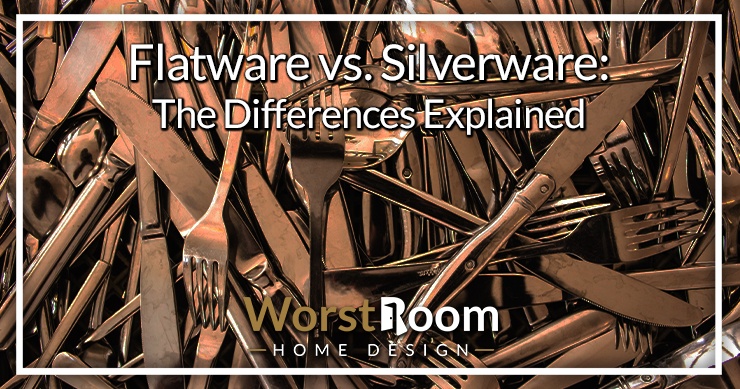
Although many of us use the terms interchangeably, silverware and flatware are two different things. In our flatware vs silverware guide, you'll get to know the unique features and uses of both utensils types.
Whether preparing for a formal occasion or buying new tableware, you must know the differences.
Silverware and flatware mainly vary in material and price range. Anything on your dining table made of silver can be recognized as silverware. However, not every dining piece can be called flatware.
Let's dive deep into the definition and differences between both tableware types and find out which one is appropriate for specific occasions.
What is Flatware?
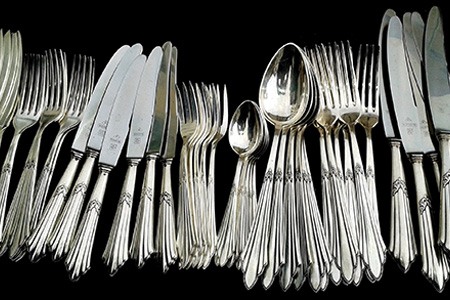
The word flatware can be elaborated as flat tableware. It is used to address a dining table's eating and serving utensils. So, everything you use to serve and eat meals, from knives to forks, is referred to as flatware.
Although knives should be considered cutlery, a regular flatware set will include them, as knives are generically included in the list of flatware by natives. All types of spoons, forks, and knives comprise a typical flatware set.
Flatware is available in many different materials such as plastic, silver-plated, aluminum, copper, acrylic, and stainless steel. You can buy them in various designs as well. The price of a flatware set depends on the material type, style, and the number of utensils.
What is Silverware?
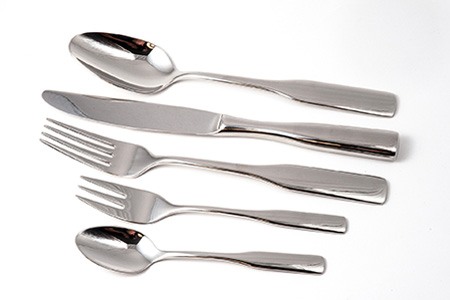
Every piece of utensils made of silver and placed around your plate can be referred to as silverware. So, if your flatware is made of silver, you can call it silverware. In general, silverware contains around 92% of silver, and various other metals consist of the remaining 8%.
This is done to enhance the strength and durability of utensils. Silverware is commonly used for formal occasions. It also costs higher than typical metal flatware.
What is the Difference Between Flatware & Silverware?
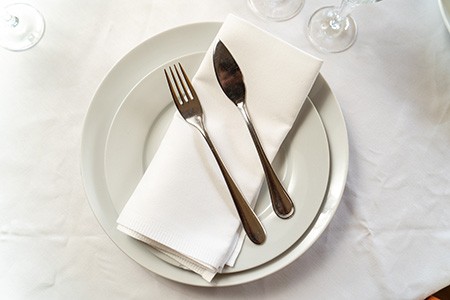
As you can see, flatware and silverware have many similarities. Hence, many people often get confused between these two. However, there's not just one difference between flatware and silverware. Here are the most noticeable ones…
Materials
Nowadays, you can buy flatware in many different materials. Plastic and acrylic ones are among the cheapest. Wood, copper, stainless steel, silver-plated, and gold-plated ones are on the expensive side. This is the key difference in the flatware vs silverware discussion.
On the other hand, silverware is only made of silver. Pure silver-made utensils are called sterling silver. However, this type of silverware isn't very common. In most cases, silverware contains other metals along with the silver to increase the strength of the utensils.
Look & Feel
Silverware is undoubtedly the better option if you want to add elegance to your dining room. Silverware is a must for staging a dining room properly, showing class and sophistication. The grayish glow of silver utensils reflects light and quickly upscales the look and feel. Besides, you can find silver utensils in different styles and patterns.
Flatware is mostly available in stainless steel. While it's a common shiny material, it lacks the luxurious vibe of silver. Copper and gold-plated flatware can be a great alternative in this case. The golden gleam will easily impress your guests and add a classy feel to your dining.
People ask often if stainless steel is waterproof or not, and while it obviously is, that doesn't mean it won't tarnish if you let it sit for long periods of time in high moisture or in liquid. Let's look at maintenance next.
Maintenance
Stainless steel is a stronger material than silver. Hence, it's easier to clean and maintain. As the material is resistant to scratches, you can toss your flatware in any types of dishwashers. It can effectively withstand kitchen abuses for years.
However, when it comes to durability, silverware is the clear winner. Although silver is a relatively softer material, it is mixed with other metals, enhancing its durability.
If you want to maintain the shine of your silver utensils, regular maintenance is a must. Keep in mind that silverware can be easily scratched if you use any abrasive cleaning product.
Cost
Silver is a rare material and 100% silver-made utensils are even more difficult to find. Besides, silverware has a luxurious feel to it. All these make them way more expensive than regular flatware. This is a big difference between silverware and flatware.
Since stainless steel, plastic, wood, and other materials are readily available, flatware is pretty affordable for everyone. However, nowadays, flatware is made from fancy metals like gold and copper. In this case, the cost will increase depending on the availability and strength of the metal.
Silverware or Flatware: Which Should I Choose & When?
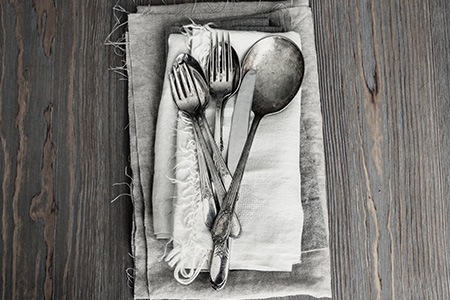
Now that you know the differences between the two types of tableware, it's time to know which one you should choose and when. Whether you choose silverware or flatware, we would say it depends on your budget and the occasion you're using them for.
Both silverware and flatware are used for the same purposes: serving and eating. However, flatware is a more suitable option for casual occasions like birthday parties and everyday dining. It will easily suit your budget, whether stainless steel or plastic.
To make your flatware unique without spending much, you can go for wood or gold-plated utensils. If you're arranging a fancy Christmas dinner for your family and colleagues, you should choose silverware for a high-end look.
Of course, sterling silver is the best option, but you can go with regular silverware as well. Please pay attention to the next part, as it's the most important part of the flatware vs silverware consideration.
We don't recommend using silver utensils for everyday meals as they tarnish and stain if not cleaned properly right after use. Also, the silvery shine will fade due to frequent washing and regular wear and tear.
So, use silverware only for formal occasions and ensure regular upkeeping and polishing to maintain the look for several years. Do not polish stainless steel with Windex or any ammonia-based cleaner.
The Meaning of Stainless Steel Flatware Numbers
You've probably seen on packages of flatware when browsing a store's selection that nearly all of them feature a set of numbers, usually 18/0, 18/8, and 18/10. What do these flatware numbers mean?
The numbers refer to a system of grading related to the composition of the stainless steel. The number 18 that you see at the front of the sets means that the ratio of chromium in the steel is 18. That's pretty standard for flatware.
The second number refers to the ratio of nickel in the steel. You can have zero nickel or at most (usually) a ratio of 10. This is where your choice will be made. More nickel means more durability and more shininess to the look of the stainless steel flatware.
The conclusion to be made is that the 18/10 grading is the highest quality in terms of durability and look, while 18/8 is still okay and could save you a little bit of number. 18/0 will be of the lowest quality and ultimately will suffer in appearance over the course of years, which means corrosion and pitting.
Types of Flatware
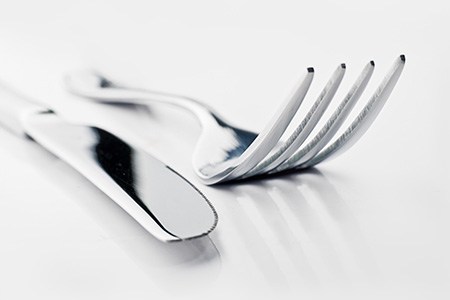
Flatware utensils can be divided into different categories depending on the material. Each material has some benefits and drawbacks. Here are the most common flatware types:
Stainless Steel
This is undoubtedly the most used material for flatware all over the world. Stainless steel is an alloy of a few metals which make it strong and resistant to everyday wear and tear. Thanks to the excellent finish on stainless steel flatware, it effectively prevents rust and corrosion.
The addition of metals like nickel and chromium makes it scratch-resistant too. So, stainless steel flatware can easily be cleaned every day with almost any type of cleaner. While buying this type of flatware, you'll find many different grades like 18/0, 18/8, 18/10, etc.
These grades are allotted depending on the percentage of nickel and chromium. We recommend going for 18/8 or 18/10 flatware as the amount of nickel is higher in those utensils. As a result, they are more resistant to corrosion over time.
Plastic
We all have used those disposable plastic spoons and various types of forks. But, plastic flatware isn't always cheap or low-quality. Besides the transparent and disposable ones, many different types of plastic flatware are available on the market today.
They come in different colors, coatings, and thicknesses. Thick and colorful plastic flatware is often used on formal public occasions. You can go with better quality plastic flatware like premium rose gold to impress your guests without spending much. However, you can't wash plastic utensils in your dishwasher as they might warp or crack.
Acrylic
If you prefer colorful utensils with unique patterns, acrylic flatware is a great option. These utensils are basically stainless steel with acrylic handles. You can easily customize the design and patterns on the acrylic handles of your spoons, forks, and knives to make them stand out.
Acrylic flatware is suitable for both formal and informal occasions. However, the design on the handle can fade away over time, especially if you toss them in the dishwasher.
Electro-Plated
To add some uniqueness to the typical stainless steel flatware, utensils are often electroplated with copper, gold, silver, etc. In the electroplating process, the base metal (stainless steel, brass, nickel) is coated with a layer of shiny metal.
This metal coating not only enhances the look of the utensils but also improves their durability. While electroplated flatware is cheaper than sterling silver, it's still a pretty expensive option. So, people only use them for special events.
The main drawback of electroplated flatware is that the metal coat wears off and exposes the underlying base when used frequently. You need to maintain the flatware and keep it away from abrasive cleaners to keep the finish intact.
Remember, some low-quality electroplated utensils will affect the taste of your food. So, be careful while choosing this type. This is only a concern with flatware, and if this matters to you (it's not as subtle of a taste as you might think, either) then let this be the deciding factor for you in the flatware vs silverware debate.
Types of Silverware
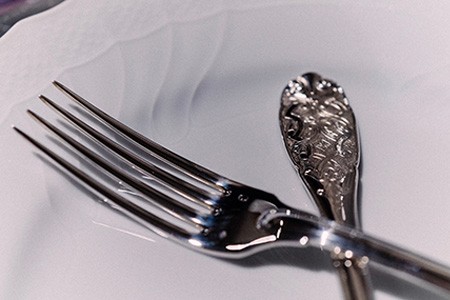
As silverware is only made of one metal, there aren't many varieties available. The two types of silverware include:
Sterling Silverware
You might know that solid silver or gold are soft metals that easily deform. So, solid silver or gold isn't suitable for making utensils. Silverware that contains around 92 to 92.5% silver is known as sterling silver. The remaining 7.5% to 8% of the weight consists of other stronger metals like copper.
To maintain the look of your sterling silverware, you have to polish them regularly. Also, avoid putting them in the dishwasher and clean them as quickly as possible after use. Use a non-abrasive cloth or sponge with warm water and mild soap.
Silver-Plated Tableware
Similar to other electroplated flatware, silver-plated utensils also have a base of copper, nickel, or some other metal covered by a silver coat. Although the percentage of silver is low (it's really high in silverware vs flatware), silver-plated utensils still have a premium silvery look.
Silverware Patterns
This isn't a type of silverware but describes the patterns built into the silverware, which changes the amount of elegance or modernity in their design. For your choice of aesthetics, you can choose largely from:
- Chantilly
- Francis I
- Grand Baroque
- Old Master
- Prelude
- Repousse
- Rose Point
- Royal Danish
Some of these designs have more historical significance than others, being older, less prevalent, or used by royalty in the past. I'd recommend choosing what you like and not worrying too much about any meaning behind them, but that's me.
Flatware vs Silverware: A Decision to Be Made
Another key difference between the two tableware is maintenance. Silverware needs regular polishing and careful cleaning to maintain its shine. On the other hand, you can use stainless steel flatware whenever you want as it's durable and resistant to corrosion.
So, that was our take on the flatware vs silverware discussion. By definition, any flatware made of silver can be called silverware. However, flatware is usually made of other cheaper materials like stainless steel, plastic, or acrylic.



